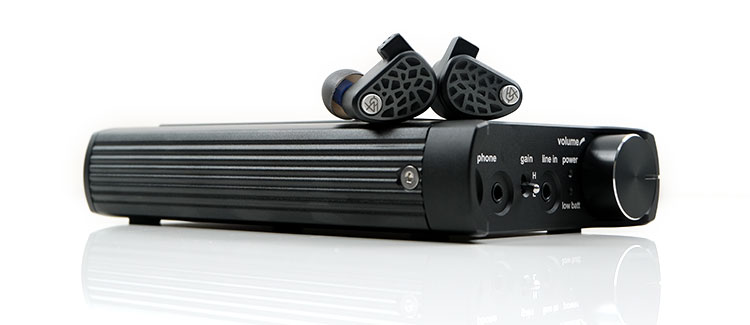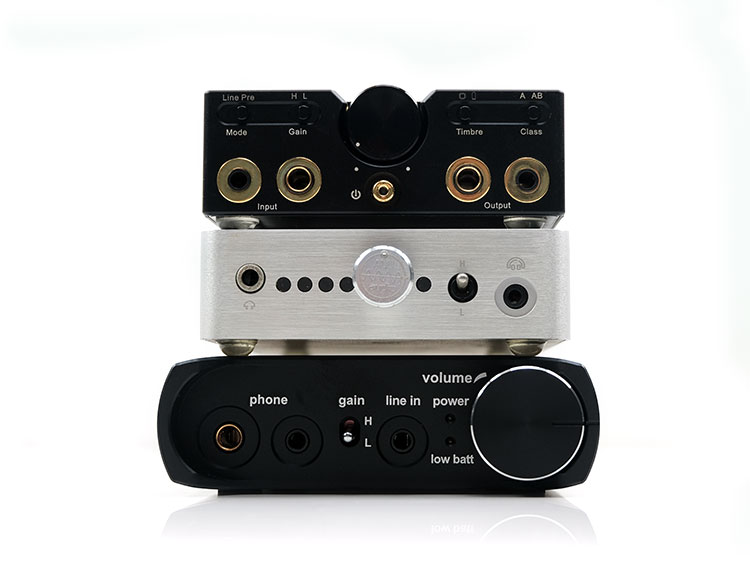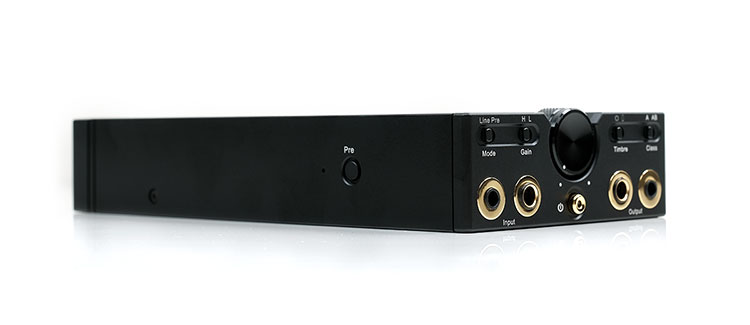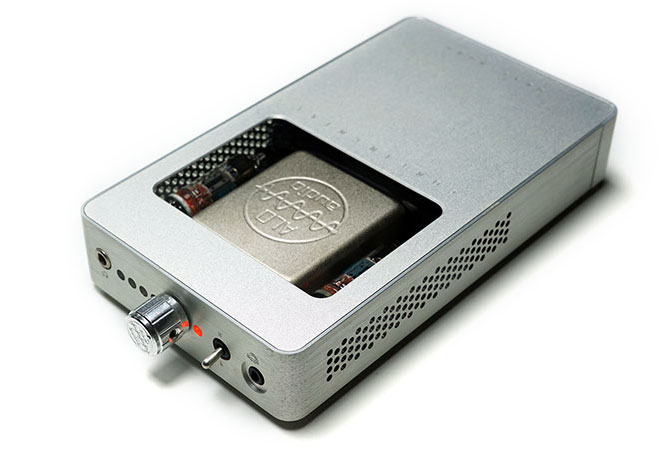Synergy
Efficiency
The Phatlab Chimera does have a sub-ohm output rating but for monitors, I would quicker pair it with medium efficient offerings than super sensitive IEMs.
For example, on SE low gain, the likes of the 105dB SPL 64 Audio tia Trio and the 106dB U18s did very well indeed with almost no background hiss.
Hiss did start to creep in when we moved to the Chimera’s balanced output on low-gain and fairly disruptive on high-gain for both outputs. For monitors like these, I would advise sticking to SE low gain for the best noise floor performance.
We did have problems with the noise floor on both outputs with Campfire’s Andromeda 2020 and the Solaris. Here I would draw a line and say these are not the best pairings for the Chimera as its gain levels and noise floor are not suited to Campfire’s sensitive gear.
The Chimera, however, does very well balanced low or high gain with harder-to-drive planar monitors such as the Audeze LCDi4 or electrostatic-infused hybrids such as the Vision Ears Elysium.
Here I suggest is where you will find the most joy with both pairings hiss-free and decent room on the pot for a micro-level of volume control in low-gain. There is a little bit of channel imbalance to the right side at low volume, however, but on comfortable listening levels, the channel balance is perfectly fine.
Microphonics
The only real caveat I have is the high tube microphonics with all monitors, especially when plugging the jacks in and out which seems to prolong it even. If you want to wait until the ping is gone before playback it can take up to 30 seconds.
My tip is to start in JFET mode, plugin, then switch to tube mode and you will avoid the ping but watch for the initial contact pop event in JFET mode which can be a bit jarring.
Power
Here I would say the Chimera becomes a force to be reckoned with. Headphones are more at home with the Chimera with moderate and medium efficiency planars as well as demanding dynamic driver headphones.
None of our tested headphones presented any real challenge in terms of a high noise floor, unacceptable tube microphonics, or sounding inadequately driven. This includes Hifiman’s Ananda and the Sundara, as well as the Sennheiser HD600/650 combo.
If possible I do recommend using the balanced output for the Sundara and the Sennheisers for the additional power but the Ananda sounds perfectly fine from the SE output also.
What I noticed most with headphones was how much better they were at teasing out the differences in the bass performance between the JFET and the tube output compared to monitors.
With Ananda, for instance, I felt the tube output was superior to the more sedate JFET performance. Not just the sparkle up top but also the bass had an added dimension in terms of weight and fullness that did not seem to be present in the JFET setting.
What you do get with the JFET is a bit of balance and a slightly smoother delivery in the mids and treble which I found overall to suit the Sundara’s high-energy treble delivery a bit better than the tube output.
With the HD600 I could go with either setting but the JFET slightly intimate and calmer tuning seems to gel well with the tighter staging property of the HD600 whereas the tube setting gave the HD650 mids and treble a welcome lift.
Select Comparisons
Cayin C9
$1999
Technical
Granted a higher priced model but the C9 does share several similar traits such as the dual operational mode between solid-state and tube. Internally, the circuit topology is a bit different and I suspect this is where a lot of those additional dollars are invested in.
The C9 dual-operational mode primarily allows you to switch between a Class A and Class AB circuit topology but additionally, and like the Chimera, it can switch between solid-state and tube for timbral control. That gives you four choices instead of two as both the dual operational mode and the timbral modes are independent of each other.
The Chimera will allow you to switch between a JFET solid-state or a tube output but the circuit topology is unchanged as in you do not have two different Classes of a circuit in one box.
Additionally, the C9 has an independent balanced and SE topology meaning it can input and output true balanced and dedicated 3.5mm LO. Even though the Chimera has a different output level for 4.4mm and 3.5mm it is an SE circuit topology so the input is only a dedicated 3.5mm LO.
The tube implementation is also quite different between them. The C9 uses a newer and more expensive Korg NuTube 6P1 with a spring-loaded suspension system. the Chimera uses the more traditional dual Jan 6418 subminiature tube design.
Numbers
A little bit tricky to compare outside of the core output power parameters but what we do know is the SNR of the Chimera is >110dB which is pretty close to the C9 tube performance of the C9 at 112dB on its SE output which is the equivalent measurement.
Beyond that, the balanced output of the C9 is higher at up to 2.6W into a 32Ω load so the better choice for demanding headphones. However, its SE at 700mW into 32Ω is a little less compared to the 4.4mm output of the Chimera which is rated at 1W into 30Ω.
Remember the Chimera is an SE circuit not balanced so the above is an acceptable comparison but on a socket per socket basis, the 3.5mm output of the Chimera is much lower at 300mW.
Design
The C9 is a bit heavier at 550g and also marginally longer. The Chimera is wider and at 370g substantially lighter. Both are portable though being battery powered but how portable you feel their sizes are may well be a thing of preference.
The C9 design flow is perhaps a bit more uniform with its matte black aluminum panels all around whereas the Chimera opts instead for functionality with grippy curves and protected panels. The C9 does have a recessed volume pot but it’s a little more prone to accidental bumps. The Chimera volume knob could do with offering more grip, however.
Both have almost all I/O to the front with the Chimera opting to place the amplifier mode to the rear along with charging whereas the C9 only has USB charging to the rear. Both are USB for charging but the C9 has the more modern USB-C port as well as interchangeable 18650’s inside.
Battery life is competitive for both with the Chimera rated at 10 hours and the C9 at 9.5 hours for its tube output and 10 hours for balanced solid-state. The C9 does have an edge though for solid-state SE at 15 hours.
The major I/O difference is the balanced input on the C9 and the ability to switch both operational mode Class and timbre (tube) whereas the Chimera is purely SE for LO and JFET/tube for its modes on the rear.
Noise Performance
Both amplifiers are as quiet as a church mouse on the SE output for the JFET stage and the Chimera a little higher for noise or background hiss using a 105dB SPL monitor for balanced compared to the C9 which remained very quiet. Channel balance is more even on the C9 for both outputs at low volume.
On tube mode on SE low gain, again both amps have low noise floors and with high gain, the Chimera exhibits more noise and hiss compared to the C9 which remains very quiet. Tube microphonics is also more prevalent on the Chimera compared to the C9’s Korg spring-loaded NuTubes, particularly when inserting jacks.
Timbre
In the case of the C9, the low-end weight is just a little bit stronger, particularly if you switch to the solid-state Class AB mode. It is also heftier with a better bass extension even on its Class AB/tube mode.
With the Chimera’s JFET, the low end actually sounds more linear than the tube alternative so I would say it is still more neutral in weight compared to the C9 at its most relaxed which is Class A.
Not that the Chimera lacks bass extension but simply the C9 sounds more planted with a better bass fundamental whereas the Chimera has smooth delivery with more of a spacious mids focus. The C9 is a little richer and fuller sounding, more energetic in solid-state but more relaxed and warmer using the timbre mode in the lower mids.
The two amplifier tube modes also differ on the treble extension and vocal timbre. Here the tube mode of the Chimera sounds the more ethereal of the two with a bit more energy that creeps into the tone of the vocals.
The C9 vocal sound is also slightly thicker with only a minor sharp overtone on the solid-state Class AB, whereas the Chimera sounds sweeter, cleaner, and airier from the vocals up into the treble.
Vocals presence on the Chimera Tube mode sacrifices a little body for that airy tone compared to the relaxed imaging of the C9 tube timbre mode, especially in Class A.
ALO Audio Continental Dual Mono
$1495
The CDM is both a portable tube/SS hybrid amplifier and an integrated DAC so those who opt to buy the Chimera with the integrated DAC will be on a like-for-like basis. The Chimera we have here is the amplifier alone so we will compare both amplifier outputs with the same external source.
Technical
Internally, the CDM amplifier stage uses a dual-tube design in its amplification topology with Class A and Class AB stages. The CDM uses Class A only for the tube output and Class AB is purely for the solid-stage output component. It does not have a switchable mode like Chimera’s dual-mode JFET and tube functionality.
The choice of tubes is quite similar, however. Both use subminiature tubes with the CDM equipped with a pair of New-Old-Stock 6111 Vacuum Tubes and the Chimera loaded with two Jan 6148 pentode subs used as triodes in the circuit.
Output power is a big differentiator here with the Chimera much stronger going SE and balanced and with a modern 4.4mm pentaconn output. At 32Ω you are only getting 80mW and 125mW balanced on the CDM whereas the Chimera is 300mW into 3oΩ for SE alone and up to 1W balanced. If you want power then the Chimera is the stand-out choice here.
For IEMs you would think the lower power of the CDM might be better for noise floors, however, its noise floor is a lot higher than the Chimera, at least in our real-world testing with sensitive IEMs. Both do have a little channel imbalance at low volumes with IEMs which is normal for analog pots but it’s a little more pronounced on the CDM.
Design
I do love the retro styling of the CDM, it has character with its lightly curved aluminum chassis, venting to the sides, and that Gorilla Glass portal at the top to allow for maximum tube glow.
The Chimera has a more modern subdued black aluminum chassis but does match the CDM for the portal on top to allow the tubes to shine. The Chimera also dissipates heat much better than the CDM which can get quite hot.
The Chimera is only slightly longer than the CDM with a similar height but still a fair bit wider. I do not have the official weight of the CDM but it’s marginally heavier than the Chimera and much lighter than the C9 so I would put it around the low 400g region.
The CDM design does have some operational flaws, namely socket spacing which the Chimera’s wider base is better equipped for. The CDM sockets are incredibly close to each other on the rear panel making it a bit of a challenge to use the USB, power via its supplied power cable, and line-out same time.
Finally, the CDM does have balanced and unbalanced inputs and outputs (PO/LO) but they are the older 2.5mm TRRS type and not the newer and more stable 4.4mm balanced connection.
Noise Performance
The noise floor on these two amps are relatively similar on a low SPL monitor of around 105dB which means nice and quiet on SE gain and balanced on low gain and a fair bit of noise on high gain with both outputs.
The Chimera SE on high gain has less hiss than the CDM equivalent so slightly friendlier for low SPL monitors such as the 64 Audio tia Trio and the VE Elysium but I still recommend the SE output low gain on both for the best noise floor performance.
Both amplifiers have a little bit of channel imbalance at low volume levels with their SE and balanced outputs.
Timbre
There is a bit of a difference between these two tube amplifiers. The Chimera sounds the livelier and more articulate of the two through the mids whereas the CDM sounds more sedate with a slightly smaller and more distant stage quality but a stronger low-end response.
That doesn’t mean the vivid Chimera presentation is lacking in stage spaciousness. It actually stretches the stage better from front to back and sounds more holographic than the CDM, particularly for headroom.
The CDM does though have the better ‘grunt’ in its tube mode. That’s its major differentiator from the Chimera. It’s not a solid wall of bass, however. Rather it has a little bit more solidity, body, and warmth so instrumental timbre is smoother sounding to my ear.
The Chimera treble extends more compared to the CDM, particularly on the tube mode. Vocals do sound further forward and more lively and a little bit more odd-harmonic sparkle and sweetness in the timbre.
The JFET option brings the bias a bit closer to the CDM with a more relaxed treble and midrange, slightly smoother actually but still not quite as weighted as the CDM on the low-end.
Oriolus BA300S
$415
This is a cheaper but popular balanced tube amplifier. However, it is worth dropping in a quick comparison for those that own it and wonder if the Chimera is a worthy upgrade.
Technical
The BA300S amplification is much more limited in ambition with a single current-mode opamp diffused output and a set of micro-tubes.
It does not have a dual-mode output so its tonality is fixed and is only affected by whatever source you connect it with. It does not have a gain switch and though it is a balanced LO/PO design it does not have an alternative 3.5mm TRS LO or PO. The Chimera has both though it is a single-ended circuit topology.
There is no volume control on the BA300S, instead is controlled via your source so basically, you are double-amping as opposed to receiving a pure line-out signal which the Chimera can offer.
In terms of rated output power, the BA300S is rated 500mW at a 32Ω balanced compared to 1W on a 30Ω load from the Chimera equivalent balanced output. The BA300S pitch was always intended to pair closely with Sony DAP users so 500mW is a huge jump for the likes of the 1Z but if you are looking for a lot more power then the Chimera will offer that.
SNR is competitive between the two at >110dB for the Chimera and >111dB for the BA300S though neither has listed weighted benchmarks for those ratings.
Design
This is where the BA300S has a distinct advantage if a pure portable tube amp is your end goal. It is much smaller, more compact, and lighter. It is by far the easier of the two for handling though interestingly, I find the BA300S corning a bit sharper in the hand compared to the Chimera’s softer edging.
Neither have flashy designs with both all in black but both do allow for the almost requisite tube glow with small windows on their top panels.
Of course, the BA300S has a very simple aim and that’s to boost the signal of a Sony DAP or similar sources. It has little in the way of onboard functionality and therefore no requirement for additional interfacings such as volume, line-out, pre-amp, or unbalanced connections.
The Chimera may be bigger but it is much more comprehensive in its functionality and can handle a wider range of IEMs and headphones.
Noise Performance
Much of the distinction between these two will come down to the source player and the sensitivity of the monitors you are using. The Chimera has a lot more grunt but with it a noise floor that can be a lot higher than the BA300s via the 4.4mm output for super sensitive monitors under 30Ω or higher than around 105-110dB SPL.
The BA300S is effectively a double-amped solution so it can reflect the noise floor of your source a bit more. That means if your DAP is very quiet there is a good chance the BA300S will be relatively quiet also. However, its own internal amplification will still yield some background hiss with the likes of the Andromeda 2020 but less so than the Chimera.
Channel balance is also a bit better on the BA300S for similar IEMs on low volume via 4.4mm. With the Chimera, it comes into its own more for monitors around 30Ω upwards and less than 105dB SPL via the single-ended output.
There is no hiss with the likes of the 64 Audio tia Trio going SE on either the JFET or tube stage, for example. However, tube ping is a little more sensitive on the Chimera on both outputs compared to the BA300s.
Timbre
Both have a fairly smooth sound signature, however, with the Chimera on tube mode the tonal bias is a little more mids and treble with better staging complexity and a sweeter timbral tone.
The BA300S is the weightier of the two on the low-end with a bit more mid and upper bass warmth creeping into the mids timbre. Vocals are richer in body but lack the articulation and spatial clarity of the Chimera’s airier delivery.
The BA300s can sound a little sedate on the top end with a more relaxed presentation. If anything, the overall BA300s treble tone is more rounded and liquid in its delivery.
The Chimera treble is definitely the busier of the two in tube mode but slightly more relaxed in JFET mode. Musical passages with a lot of dynamic interplay in the upper mids and treble tend to sound clearer on the Chimera.
Both of the Chimera modes deliver more headroom and in turn, a bit more space and width compared to the weightier but less airy BA300S performance.
Our Verdict
We need more portable tube amplifiers such as the Chimera and fewer ‘tune by numbers’ creations. Something with a bit of character and purpose. It fills an obvious gap below the Cayin C9 and gives you a lot more flexibility compared to the cheaper BA300s from Oriolus.
You get two modes, one sweet and playful, the other linear and smooth, and both are optimal with medium-efficiency monitors and modern planar/dynamic headphones. Super sensitive IEMs would be a pass in my book, tube pings and background noise are just a shade too high for them to be ideal.
Of course, you can enhance that with the DAC integration but I might advise holding off on that unless you want an all-in-one desktop system. DAC components age a lot faster than analog amplifiers and the analog-only version of the Chimera is also a little cheaper.
Pair it instead with a source, I am pretty sure you change your source a lot more than a good quality analog amp such as the Chimera.
Phatlab Chimera Specifications
- Frequency Response 10 Hz – 100 kHz
- Output power (30Ω) 300 mW + 300 mW (Single-ended)
- 1000 mW + 1000 mW (Balanced)
- Headphone impedance 30 ohm – 600 ohm
- Gain Setting Hi: 14dB (SE), 20dB (BA), Lo: 6dB (SE), 12dB (BA)
- Max. S/N Ratio >110 dB
- Power supply 5V/1A via micro USB port
- Operation time (on battery) > 10 hours (amp alone) ~ 5 hours (amp + DAC)
- Charging time (>1A supply) Approx. 3 hours
- Dimensions 94 x 30.5 x 149 mm
- Net weight 370g






